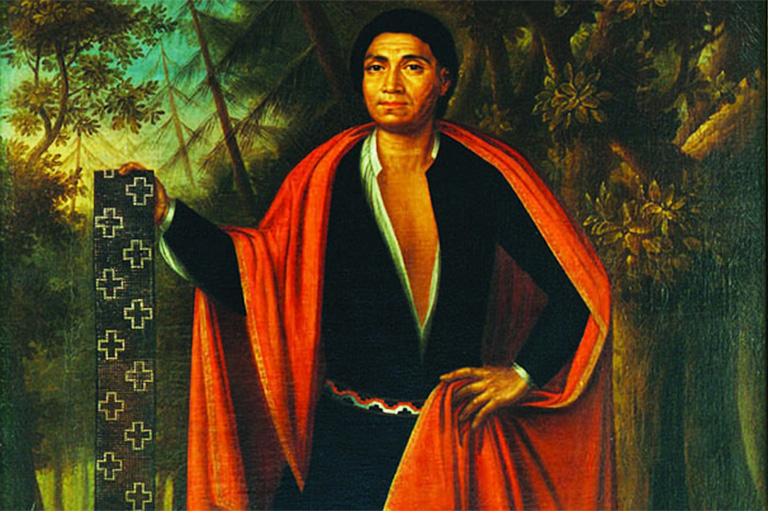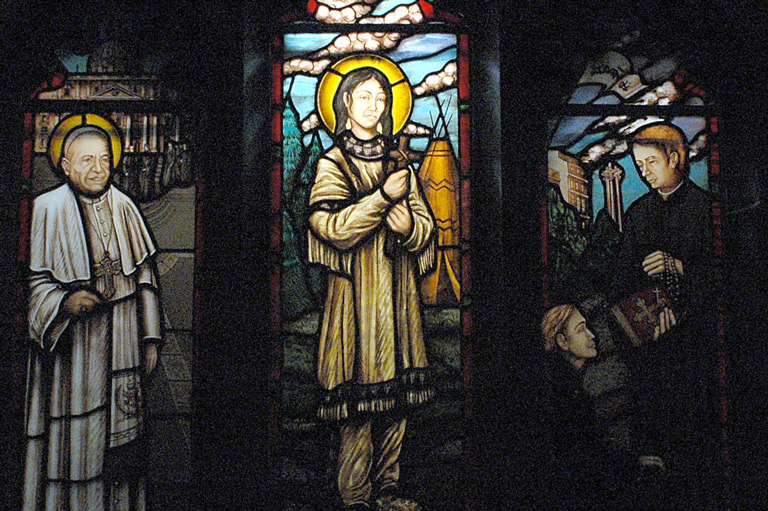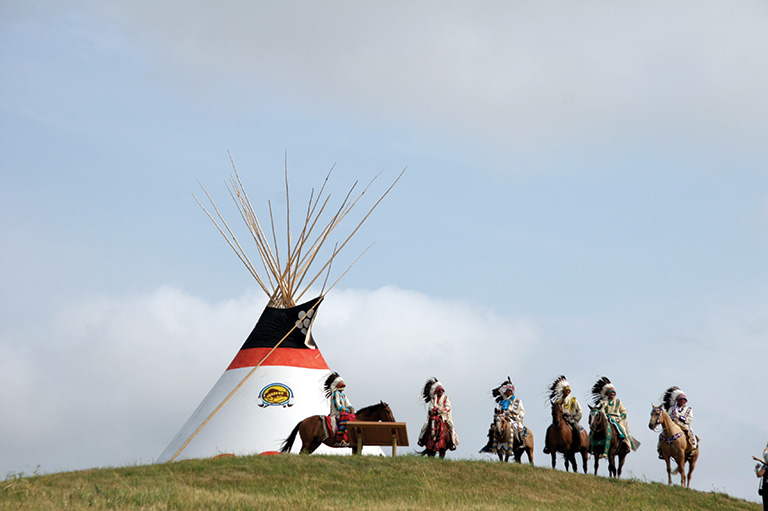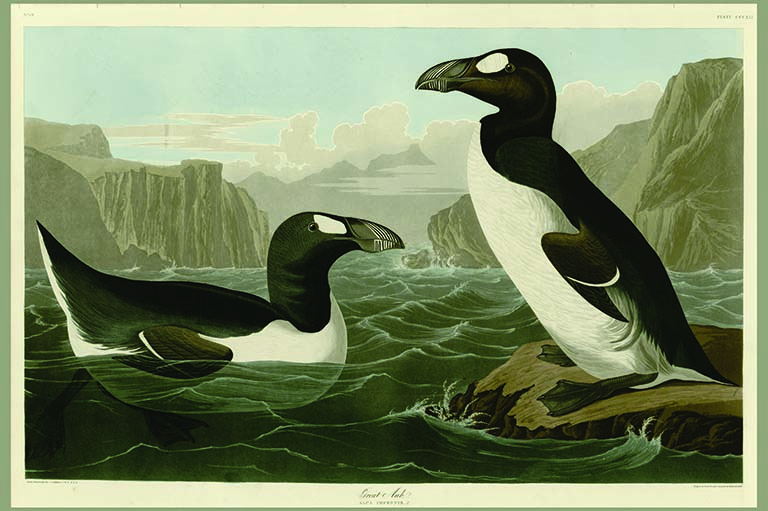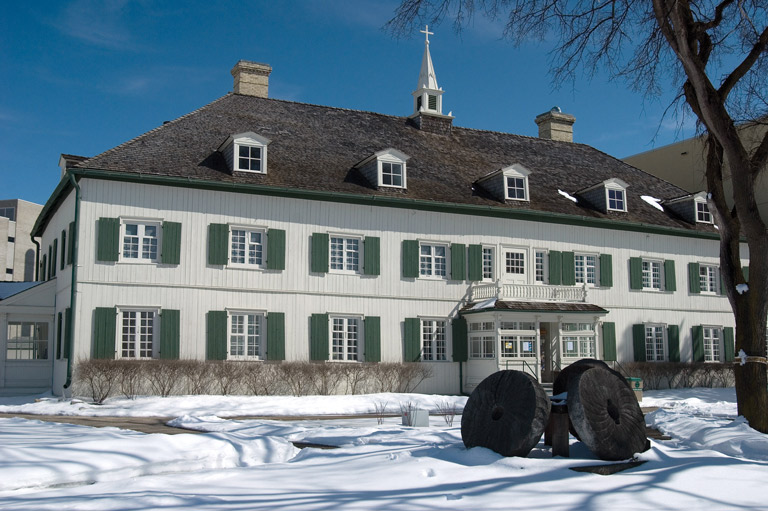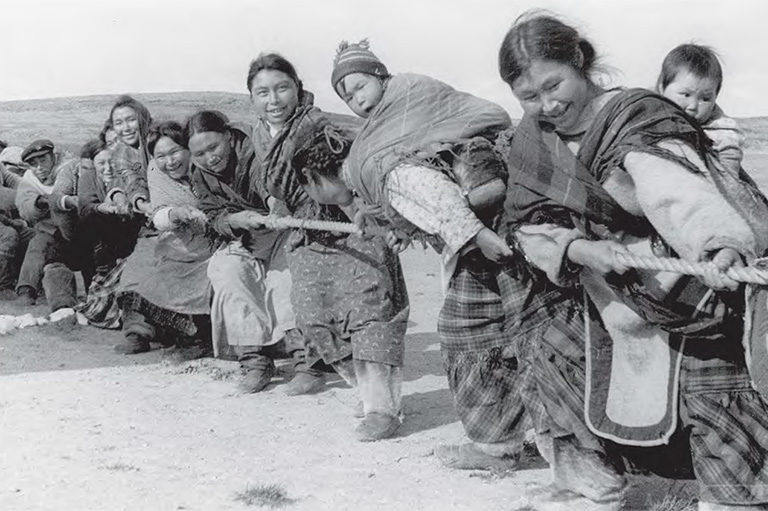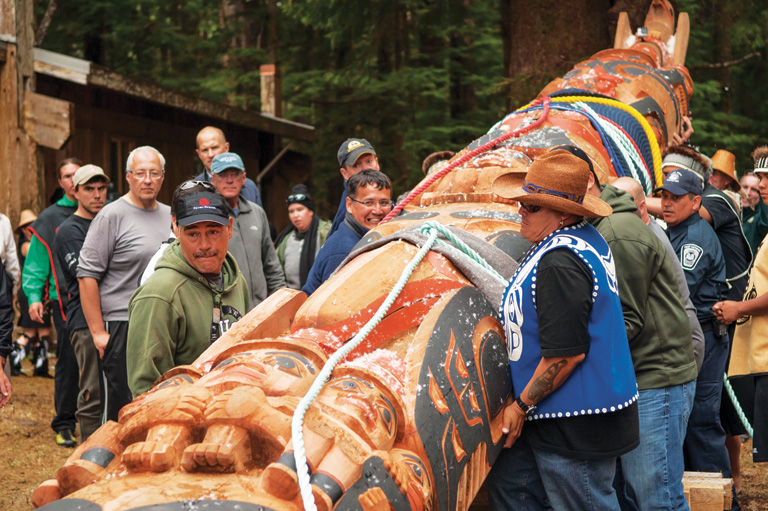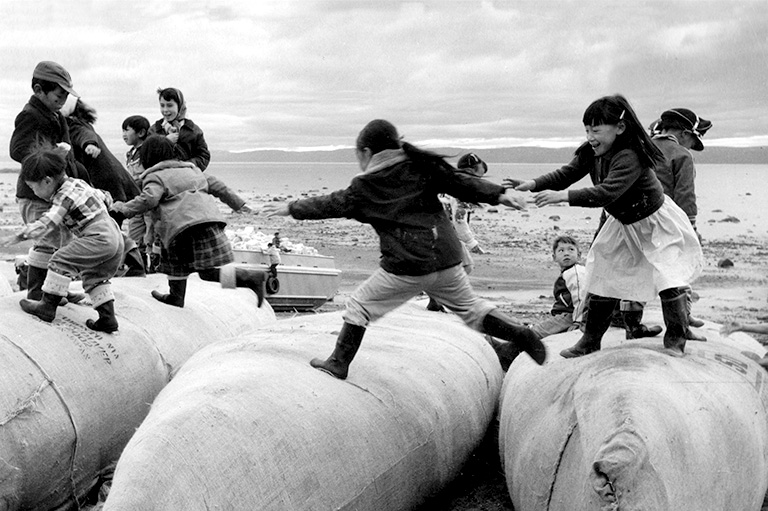Who Do You Think I Am?
The story is told that somewhere in France during the Great War, a British general, being led to the front by a dispatch runner, grew irritated with the pace set by the man and ordered him to slow down. “For God’s sakes,” he complained. “Who do you think I am? Tom Longboat?” The dispatch runner, a tall man in his late twenties, slowed and answered, “No sir. That’s me.”
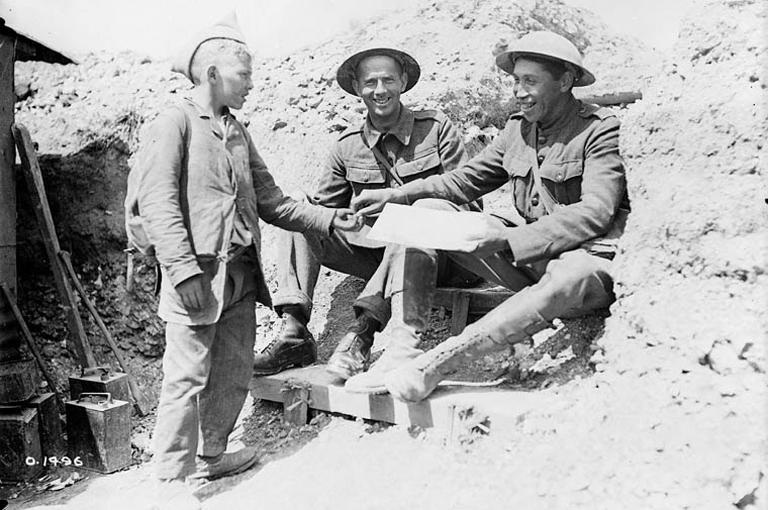
The story, apocryphal or not, hints at the fame of a young Onondagan from southern Ontario who, briefly, was one of the most celebrated men alive. Over the course of his career, millions of people assembled to watch him. When his glory faded the newspapers called him “the original dummy ... a lazy ... stall fed ... Injun,” a “stubborn,” once-talented “Redskin” who, or so the papers would have it, ended his days penniless and probably alcoholic.
Born a member of the Wolf clan and raised in the Longhouse religion, the infant Tom Longboat was christened Cogwagee. In English the name translates as “everything” and hints at the difficulties reporters would face in their efforts to define and write his story.
As a boy he was required to attend the Mohawk Institute, an Anglican residential school, but escaped, significantly, by running away. By twelve he was a farm labourer. It is said he developed his “running legs” while chasing cows in the fields and that he once ran sixty-five kilometres from Hamilton to Brantford, arriving home before his mother, who had left hours earlier — in a wagon. At nineteen he ran the annual Victoria Day race at Caledonia and placed second, catching the eye of Mohawk runner Bill Davis. Davis had placed second in the 1901 Boston Marathon behind fellow Canadian Jack Cafferty — a race joined, for several kilometres, by a spooked horse.
In 1906 he entered the Hamilton Herald race where, in a field of forty, including tested professionals, odds against him went as high as a hundred to one. During the race, he took a wrong turn and ran seventy metres before someone corrected him. He won by nearly four minutes. At first, race officials believed their watches had malfunctioned. According to the Herald, twenty-year-old Tom Longboat left his nearest competitor “as if he had been standing still.”
Advertisement
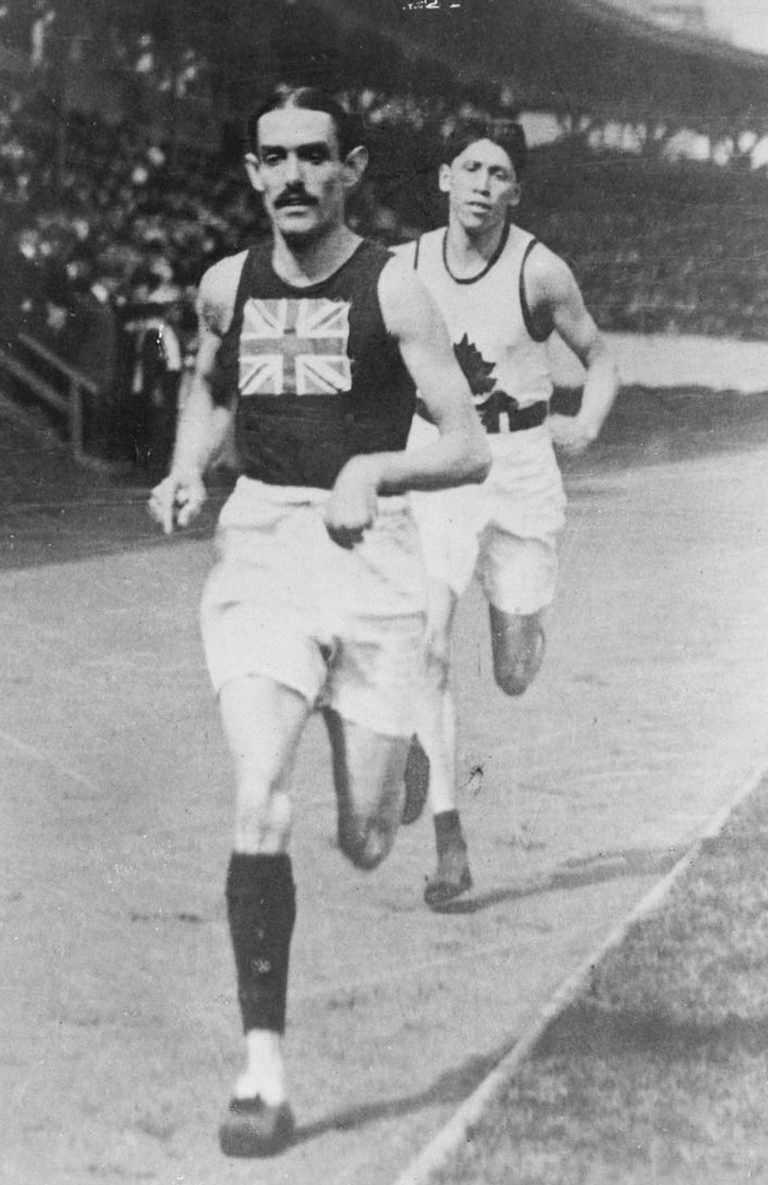
In running, this young Onondagan was engaging in a significant, if loosely understood, tradition common to many Indigenous societies in North America. Running is said to bring myths to life, to create a link between runners and the universe. It is useful in times of war.
When Cortez touched shore in 1519, within twenty-four hours runners had provided descriptions of his ships, men, and weapons to Montezuma, five hundred kilometres away. Runners of messages in the Iroquois Confederacy (Longboat was in this tradition) carried news from the Atlantic seaboard to the Niagara frontier, running day and night, and navigating by stars.
Louis Tewanima, a Hopi rival of Longboat — who at the age of eighty walked thirty kilometres a day herding sheep, and at ninety died by falling off a mountain — was said to have routinely run two hundred kilometres barefoot, “just to watch the trains pass.”
Some anthropologists suggest the strength invested in a certain Mesquakie ceremonial runner included not only “the holy power of speed,” but the power to be invisible. There are reports of a runner from southern California who left Cottonwood Island in Nevada at sunrise and arrived at Fort Yuma at the same moment he left.
It was out of this mysterious tradition that Tom Longboat emerged. With several more races under his belt, the twenty-year-old was ready to compete against the best marathoners in North America. In 1907, in one of the most celebrated sports events of all time, Tom Longboat, under the banner of the West Toronto YMCA, entered the Boston Marathon. Somehow, remarkably, his fame as a runner had spread through the intense world of long-distance running — a sport hotly followed, and sometimes dominated, by North American Indigenous peoples.
On the basis of his stunning finishes in his Ontario races, he had become an overnight legend. Newspapers were suddenly calling him “the greatest distance runner the world has ever seen.” He was made odds-on favourite to win. When Longboat shunned pre-race interviews, local writers fabricated them and rushed them into print. Unable to get a photograph, they substituted a picture of an Indigenous football player and printed that instead.
On April 19, 1907, a hundred thousand people lined up to watch the eighth running of the Boston Marathon. The route spanned forty-two kilometres, the course was hilly, and the temperatures cool. At the sound of a pistol shot, 124 runners surged forward.
At a street crossing several kilometres in, a freight train intersected the race. Ten runners, including Longboat, made it through; the rest were forced to wait more than a minute while the train cleared. Out in the hills of Boston where the race would end, a snow squall struck. Having run over forty gruelling kilometres. Longboat sprinted the final 1.6 kilometres uphill, into slanting snow, in an astonishing four minutes, forty-six seconds, smashing the course record set by Canadian Jack Cafferty by a full five minutes. His nearest competitor lagged more than a kilometre behind. It is said Longboat had picked up his trophy and was eating dinner as fellow racers crossed the line. A Boston headline stated: “Hills Held No Terror For Redskin.”
Tom Longboat returned to Toronto and to a triumph that is difficult to imagine. Two hundred thousand people lined the streets. Bands played. Reportedly, “young women gazed at [him] in rapture. Longboat, with a Union Jack draped around his shoulders, was placed in an open car and driven through the city at the head of a torch-light parade. People lit brooms on fire and waved them through the air. Streetcar drivers, unable to move, handed out unpunched transfers, having no idea when the streets might clear. Longboat, appearing uncomfortable beneath the crush of adoration, was given a gold medal and the keys to the city. “The British Empire is proud of you,” boomed the mayor, and announced a $500 gift to go to the runner's education.
With 7 uniquely curated newsletters to choose from, we have something for everyone.
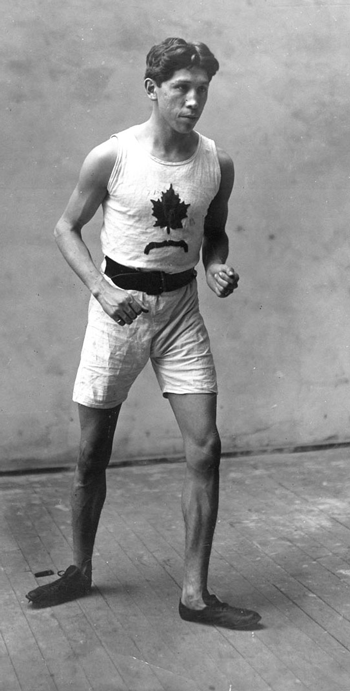
Even in the most celebrated moment of Tom Longboat’s career, newspaper writers could not conceal their discomfort with him. To the racial assumptions they had grown up with, Longboat posed a perplexing challenge.
A member of an often-named “pathetic” and supposedly vanishing race, a poorly educated “Injun,” he was also tall, handsome, and now very famous. “It is hoped that Longboat’s success will not develop obstinacy on his part.” cautioned the Toronto Star, “and that he will continue to be manageable."
“Obstinate” and “unmanageable” are the twin themes in an almost daily narrative that depicts Longboat as an animal in need of breaking. In print he became a “lanky, raw-boned, headstrong Redskin” who did not run, but “galloped.” Faced with a compliment, be “would smile as wide as a hippo and gurgle his thanks.”
Sports writer Lou Marsh described the young Onondagan “smiling like a coon in a watermelon patch.” Marsh, a popular Toronto Star sports columnist who carried on a bizarre campaign against Longboat, confidently described him as “the original dummy. ... Wily ... unreliable ... as hard to train as a leopard.”
The cultural difficulty writers faced in trying to pinpoint the man is suggested even in the quantity of nicknames they stuck on him. He was tagged the Bronze Cyclone, the Bronze Wonder, the Racing Redskin, the Wonderful Redskin, Tireless Tom, Big Chief, Heap Big Chief, the Great Indian, even the Irish Indian and, later — not yet out of his thirties — Old Tom. This confusion of titles did not so much describe a man named Tom Longboat, but the gropings of newspapermen to integrate a world-famous Canadian “Indian” into the racial hierarchies of the time.
A cruel and revealing comment came from a Toronto Star writer who, after Longboat’s triumph at Boston, wrote “His trainers are to be congratulated ... for having such a docile pupil.”
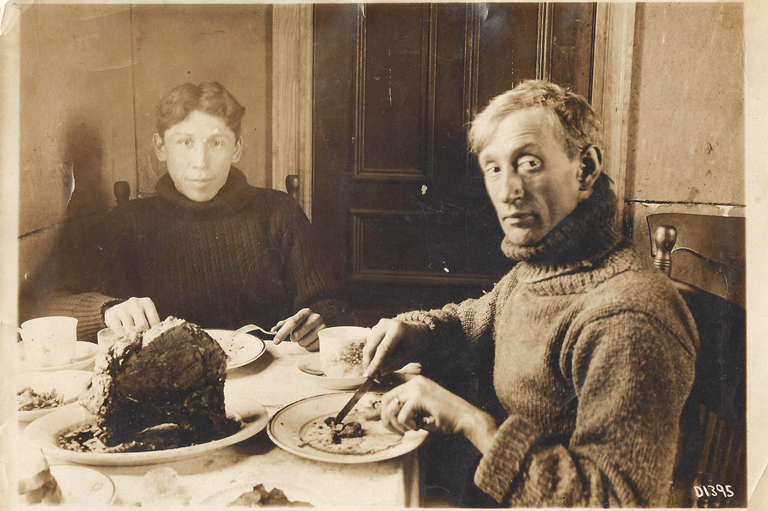
If Longboat was to gain the respect of the media, it would not be by proving himself the greatest runner in the world, which he would soon do, but by becoming “docile” and “manageable.” This would prove more difficult.
On the heels of his Boston victory, Tom Longboat was evicted from his YMCA lodgings for reasons described alternately as “breaking curfew,” smoking, drinking a bottle of beer, or being in the company of women. His management was taken over by Tom Flanagan, director of the Irish Canadian Athletic Club and a flamboyant Toronto sports promoter.
Longboat had initiated contact with a brief note to the man. The letter, all fourteen words, typifies the reserve that reporters found so maddening in him: “Dear Sir — I want to join the Irish Canadian Club. Enclosed find a dollar.”
Perhaps no one personified the seedy, freewheeling world of sports promotion as did Longboat’s new manager. Described in print as “a nattily dressed blade of twenty-eight," Flanagan made this comment about the British marathoner Alfred Shrubb: “First of all I apologize to Alfred Shrubb for hitting him. I'm not a blackguard.” He once raced Longboat twenty kilometres against a horse. Longboat won after Flanagan positioned himself in front of a bridge and insisted to a police constable that he enforce the posted bylaw: RIDERS WALK YOUR HORSE. The subterfuge proved unnecessary. The horse eventually collapsed.
Flanagan’s first concern was preserving Longboat’s amateur status so that he might run in the 1908 Olympics. This he did by setting up Tom Longboat with a job in a cigar store: Longboat’s Athletic Cigar Store. Confined indoors to a stool behind a counter, the young Onondagan did not thrive. The rumour was that he smoked too many of the cigars himself. Despite controversy, the ruling sports bodies of the day allowed Longboat to compete in the 1908 Olympic Marathon, held in London, England.
The race, today, is remembered for two reasons: Dorando Pietri’s excruciating effort in which he collapsed forty-five metres from the finish line and was escorted the rest of the way by well-meaning officials only to be disqualified because of it (which resulted in perhaps the most reproduced sports photograph ever taken); and Tom Longboat’s failure to finish.
He either stopped running or collapsed at the thirtieth kilometre, in second place, and was taken out of the stadium on a stretcher. The race was tainted by the belief that Longboat had been doped; that Flanagan had drugged his own runner to ensure his failure and collect $100,000 in wagers. (Longboat was heavily favoured.) Others put his failure down to the heat, which on that day was record-breaking.
Save as much as 40% off the cover price! 4 issues per year as low as $29.95. Available in print and digital. Tariff-exempt!
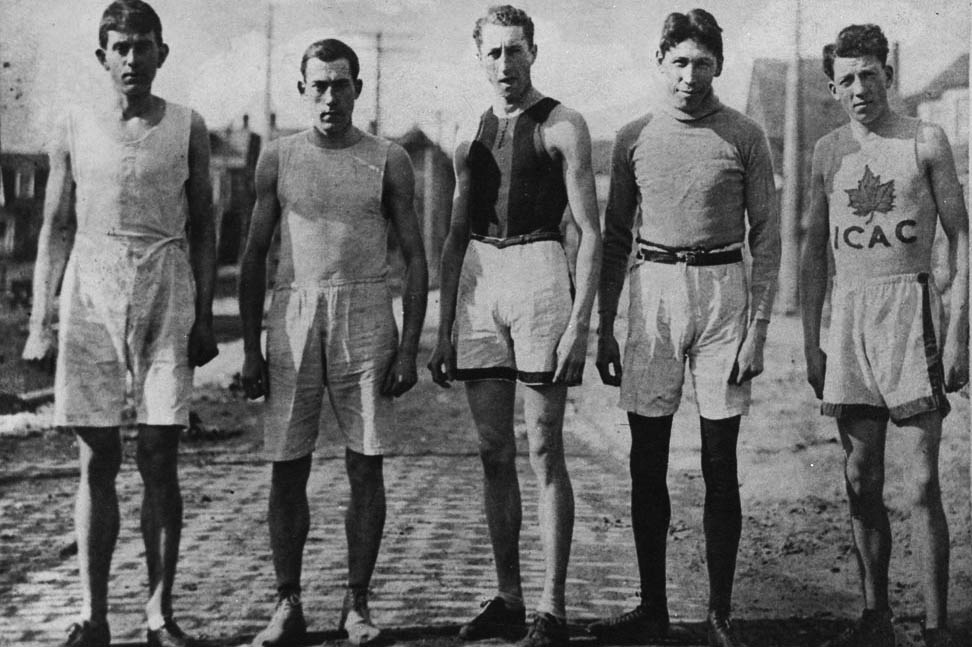
The race did not sit well with marathon fanatics on either side of the Atlantic. According to team manager J. Howard Crocker, “Longboat should have won the race. His sudden collapse and the symptoms shown to me indicate that some form of stimulant was used contrary to the rules of the game. Any medical man knowing the facts of the case will assure you that the presence of a drug in an overdose was the cause of the runner’s failure.”
In a bizarre twist, it has been suggested that sports writer Lou Marsh, who followed Longboat on a bicycle, may himself have been the person who administered the drugs. The Hamilton Spectator dismissed the whole affair: “Longboat ran a good race [but] could not stand the glare and heat. There was nothing to it.”
Longboat returned to Canada, announced his retirement, changed his mind, set a new Canadian five-mile record, won his third straight Toronto Ward Marathon, and then turned professional. Dissatisfied with Flanagan as a manager, he considered handing his management over to a Mohawk friend from Desoranto, Ontario. Sports writers were furious.
They quoted Flanagan to the effect that would-be promoters of Longboat “had sufficiently degraded the Indian by pandering to his weaknesses.” A local reverend, John Morrow, waded in: “[B]ecause the physical and mental make-up of the Indian is so foreign to any other athlete’s, and his disposition so hard at times to understand ...I can safely say that no other man ... could have managed Tom Longboat but Flanagan.”
Flanagan and his client patched up their differences and on November 11, 1908 — in his first race as a professional — Longboat defeated a three-man relay team over eight kilometres. A month later he raced Dorando Pietri at Madison Square Garden.
Crowds were so thick that Pinkertons was called in to reinforce police. Inside, the Garden’s arena was a dense pall of tobacco smoke.
Through this barrier the two men would be expected to run forty-two kilometres — two hundred and sixty laps. Neck and neck for the entire race, Longboat, in a characteristic burst, pulled ahead. Dorando, straining to close the gap, collapsed and was carried unconscious off the track.
Two weeks later Longboat married a Mohawk woman, Lauretta Maracle. The Globe wrote, approvingly, that the new bride “does not like to talk of leathers, war paint or other Indian paraphernalia. ... If anyone can make a reliable man ... of that elusive human being, it will be his wife.”
Since her Mohawk name translated in English as “The Leader,” cutline writers could safely state: “Mrs. Longboat will therefore be the Leader of Everything.” Nothing could shake their notion that Tom Longboat needed to be led. A photo shows the newlyweds posed with a noticeable and telling distance between them.
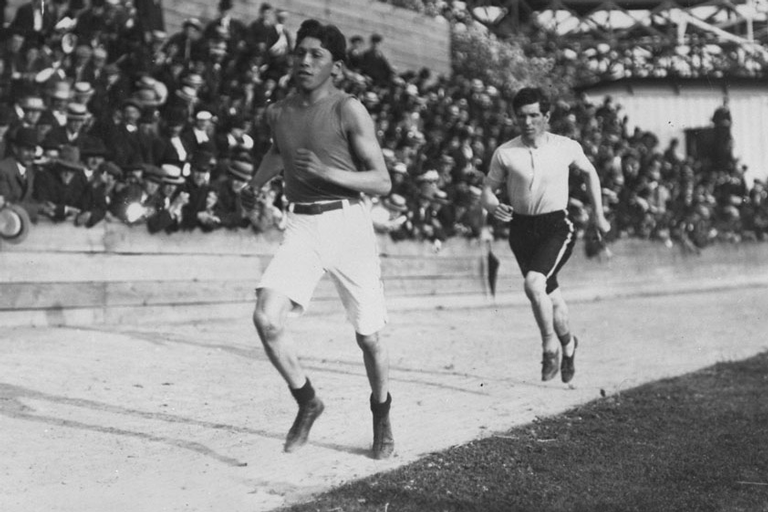
Five days after the wedding, Longboat raced Pietri for a third time. In front of eleven thousand people indoors at Buffalo, the two runners clocked a time of two hours, twenty-six minutes, over the first twenty-four kilometres. Even Lou Marsh admitted a time like that “is not an exhibition by an extra lively tortoise. It is drilling from the drop of the hat.”
Sniffing repeatedly from “a little brown dope bottle,” Dorando veered off the course at thirty kilometres and collapsed into the arms of his brother. Longboat, bleeding at the knees, walked and staggered the remaining distance.
At the end of January, still complaining of Longboat’s unmanageability, Flanagan sold his contract to a New York sports promoter for $2,000. “He sold me just like a racehorse to make money,” Longboat told his wife. Flanagan had been best man at their wedding.
In February he raced Alfred Shrubb, the world’s ranking professional. When Shrubb took a ten-lap lead, the Madison Square Garden crowd booed Longboat. Then he began his comeback, lapping the Englishman again and again over the last ten kilometres. Tom Longboat, age twenty-three, now at the apex of his marathon career, had defeated every great runner in the world at least once.
He did not know it, but the most brilliant years of his marathon career had ended. The near mania for distance running was already waning. Nonetheless, in Edinburgh in 1912 he set a new world’s professional fifteen-mile record of one hour and twenty minutes.
Volunteering for the army in 1916, he served nearly four years with the Thirty-Seventh Haldiman Battalion. His enlistment papers describe his “trade or calling” as “professional runner.” In a delicious understatement, his certificate of medical examination declares him to have “the free use of his joints and limbs." During his time in France he saw the horrors that took place on Vimy Ridge and at Passchendaele. He was even pronounced dead — a ghostly echo of the uncertainty that clouds the public record of him.
Discharged in 1919, he returned to Caledonia to discover that his wife, after reports of his death, had married another man and taken the furniture. Eventually he married an Onondagan, Martha Silversmith, and had four children with her. In the words of a Maclean's article, written eight years after his death, “he took another squaw.”
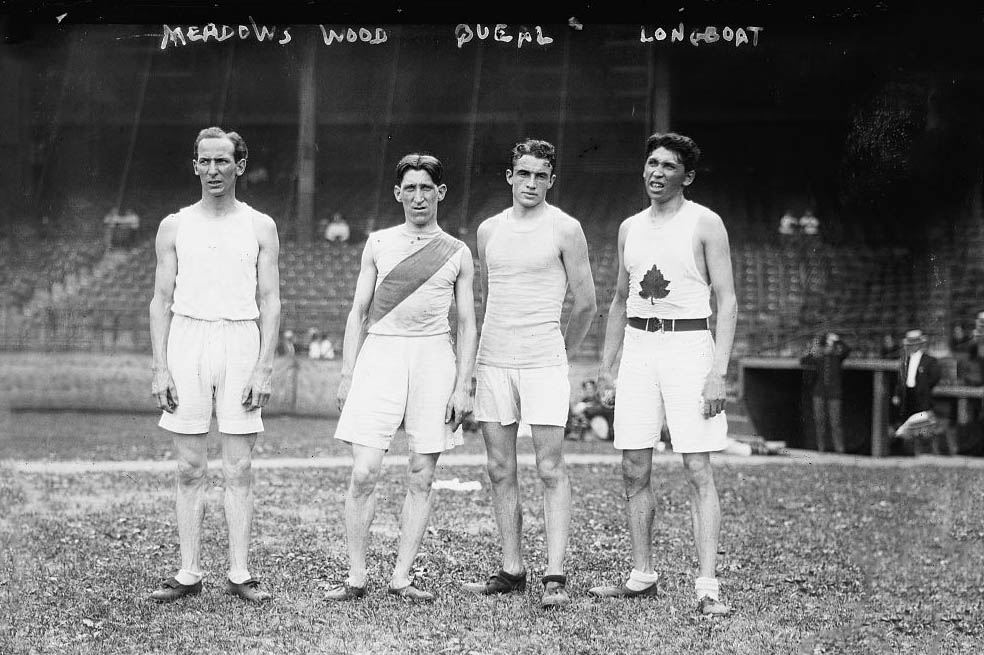
Advertisement
The early 1920s were difficult years for Longboat. Out of racing, he moved west to collect on a land grant for his war service. Near Edmonton he tried various jobs. Apparently he pawned his racing medals, a sad echo of the American runner, Ellison “Tarzan” Brown, who sold his medals to buy groceries and was struck dead by a car following an argument in a tavern. An Edmonton lawyer kept Longboat’s medals, hoping someone would reclaim them. In the end they were melted down for the gold.
In 1922 he returned to Toronto. According to one account, he was met at the station by his former manager, Tom Flanagan, who bought him a corned beef sandwich. That same year he was riding the Queen Street streetcar to south Riverdale where he earned three dollars a day as an employee of the Dunlop Rubber Company.
About that time Lou Marsh wrote, “He started out on corn pone, worked up to caviar and now is tickled to get corn beef.” In 1924, Longboat asked the Amateur Athletic Union to reinstate him as an amateur. Nothing came of his request.
He had found a job, however, which he worked at faithfully for nineteen years. As an employee of the street-cleaning department of the City of Toronto, he drove horses, swept leaves, and collected garbage. It is in this detail that journalists found their greatest satisfaction: “A rubbish man!” they crowed, “a particularly nice rubbish man ... an Indian rubbish man.”
“He worked his way to the bottom,” wrote Fergus Cronin in a 1957 Maclean’s article — a low point in Canadian journalism. When Grolier’s published its 1957 Encyclopedia Canadiana, the brief entry on Longboat would be drawn entirely from this gloating and contemptuous article.
In 1930, Longboat, now a forty-five-year-old family man, was again in the news. A November issue of the Toronto Mail and Empire announced that an enemy of the Six Nations had directed “bad medicine” at Longboat and was killing him.
Of all the mountains of newsprint written about the man, this piece stands alone for the unexpected respect it shows toward Longboat and traditional beliefs. In the interview, Longboat talks freely about Indigenous medicine: “The medicine men can do strange things. If a dog comes into their room they can make themselves into that dog. Or they can be in the bear and then be men again. You can see it on the reserve. They can do anything.... People laugh about that wisdom and learning, but they do not realize that they do not know everything.”
This is one of the only indications in print that Longboat was capable of anything but “guttural grunts.” The piece also provides an intimate picture of the Longboat household. His wife, the “squaw” of Cronin’s article, here is a “slim woman ... soft-spoken and courteous.” Even his four children warrant names. Apparently the medicine men were capable of helping Longboat for his malady disappeared.
In 1932 occurred the most tragic moment in his life. Attending the Canadian National Exhibition with his family, Longboat stopped to give an interview with radio personality Jane Grey, voice of Princess Mus-Kee-Kee. She asked him if he would like to say hello to anyone.
“He told me he would like to speak to his daughter. ... Apparently some playmates heard me say this and rushed to call his daughter to the radio. She raced across the path of a car and was instantly killed. ... I think she was about eight years old.”
Even here, in this moment of anguish, the story strays, and the facts become perversely mangled. He did lose a child; it did happen following a radio interview at the CNE; that child was struck dead by a car. But the child was a son. His name was Clifford. He was five years old.
For the rest of her life, Martha Longboat kept the CNE pennant she’d bought that day, passing it on to a son prior to her death. The Maclean’s article, which remained the definitive piece on Longboat for thirty-five years, omits this tragedy, preferring to dwell on his presumed poverty.
With the arrival of World War II, “Garbageman Longboat” enlisted in the Home Guard. By the end of the war he had retired from his city job and was living on the Ohsweken reserve where he was born. There was yet one ghost for him to fight — a stranger who, for more than a decade, pretended to be Tom Longboat in order to cadge drinks in taverns.
This episode has something haunting about it, as though the lazy, drunken “redskin” the newspapers worked so hard to create had risen from the pages to torment the living man. In 1948 Longboat supplied the Hamilton Spectator with a photograph of himself, in an effort to foil what he called that “cheap, two-bit imposter.”
Back home, in failing health, he walked every market day eleven kilometres to Hagersville and then back. Many years later, a friend, Frank Montour, recalled those final walks of Tom Longboat. “He was best in the world," said Montour, “and an Indian besides.”
Over the years the legend of Tom Longboat has been revised. In 1992 a small book written by former Olympic runner Bruce Kidd placed Longboat squarely within the cultural context of his times, and indicated what the man was up against. This book is now the standard source on Longboat in high-school and public libraries across Canada.
Cronin’s racist brooding has been confined to microfilm. Through Kidd’s efforts, the $500 promised to Longboat by the mayor and never paid was finally collected. With interest it amounted to $10,000, issued in 1980 to Longboat’s heirs.
The new Canadian Encyclopedia’s entry on Longboat draws entirely from Kidd’s book. Websites, school essays, histories of the Boston Marathon — all of these writings take as their starting point the racial assumptions that once defined the Longboat story.
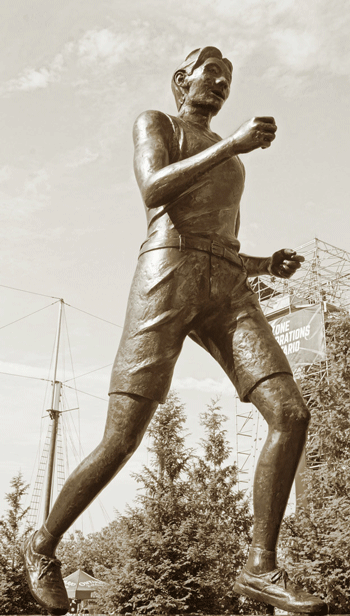
Today he is presented not as “the original dummy" but as a superb athlete, an Onondagan who strode across the earth faster, further, and more gloriously than any man alive.
He has been called Canada’s first professional athlete. He was cheered by millions. His name was pronounced in schools, homes, and churches. He received fan mail from Clark Gable, shook hands with royalty, and had a cigar named after him.
He served in two world wars for a country in which he was not even allowed to vote. He was pronounced dead. He set times that left professional timekeepers doubting their watches. He suffered the death of his own child.
For twenty years he was mocked in print by a spiteful reporter, and when that reporter died, he said graciously, “He was one of the finest men I ever met.” He negotiated the minefield of the dominant culture and even used it to his advantage.
He fled the infamy of the residential school system, and when at the height of his fame that school asked him back to give a speech, Longboat refused, saying privately, “I wouldn’t even send my dog to that place.”
Eventually he took work as a garbage collector to support his family — outdoor work, work that allowed him to move his legs across the land. He drove a car through the height of the Depression, when many Canadians could not afford bus fare.
Near the end, when reporters came running to photograph him in his overalls, collecting garbage, he told them, “I’m doing alright, just living along.”
Tom Longboat died January 9, 1949, at the age of sixty-two. His burial ceremony was conducted in the Onondagan way, and a V-shaped notch was cut in the coffin lid, so that his spirit might race freely to the next world.
We hope you’ll help us continue to share fascinating stories about Canada’s past by making a donation to Canada’s History Society today.
We highlight our nation’s diverse past by telling stories that illuminate the people, places, and events that unite us as Canadians, and by making those stories accessible to everyone through our free online content.
We are a registered charity that depends on contributions from readers like you to share inspiring and informative stories with students and citizens of all ages — award-winning stories written by Canada’s top historians, authors, journalists, and history enthusiasts.
Any amount helps, or better yet, start a monthly donation today. Your support makes all the difference. Thank you!
Themes associated with this article
Advertisement

